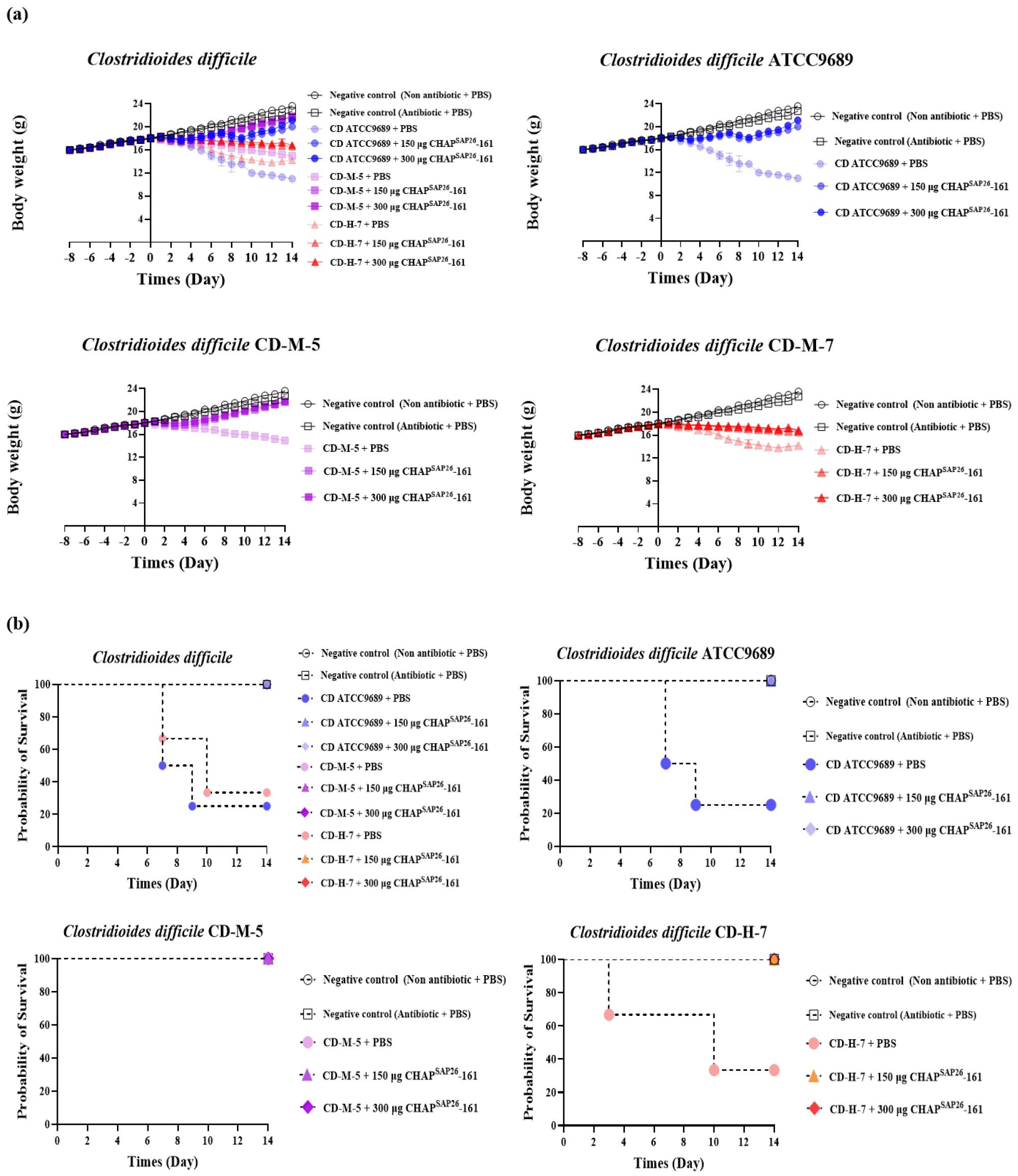1. De Wolfe TJ, Kates AE, Barko L, Darien BJ, Safdar N. Modified mouse model of
Clostridioides difficile infection as a platform for probiotic efficacy studies.
Antimicrob Agents Chemother. 2019;63(7):e00111-00119.DOI:
10.1128/AAC.00111-19. PMID:
30988143. PMCID:
PMC6591643.
2. Malone DC, Armstrong EP, Gratie D, Pham SV, Amin A. A systematic review of real-world healthcare resource use and costs of
Clostridioides difficile infections.
Antimicrob Steward Healthc Epidemiol. 2023;3(1):e17.DOI:
10.1017/ash.2022.369. PMID:
36714290. PMCID:
PMC9879868.
4. Cheng JKJ, Unnikrishnan M.
Clostridioides difficile infection: traversing host-pathogen interactions in the gut.
Microbiology (Reading). 2023;169(2):001306.DOI:
10.1099/mic.0.001306. PMID:
36848200. PMCID:
PMC10197866.
7. Bandaru SK. Toxic megacolon due to fulminant
Clostridioides difficile infection.
N Engl J Med. 2022;387:1309.DOI:
10.1056/NEJMicm2202891. PMID:
36193942.
9. Gonzales-Luna AJ, Carlson TJ, Garey KW. Emerging options for the prevention and management of
Clostridioides difficile infection.
Drugs. 2023;83(2):105-116.DOI:
10.1007/s40265-022-01832-x. PMID:
36645620. PMCID:
PMC9841950.
11. Song JH, Kim YS. Recurrent
Clostridium difficile Infection: Risk Factors, Treatment, and Prevention.
Gut Liver. 2019;13(1):16-24.DOI:
10.5009/gnl18071. PMID:
30400734. PMCID:
PMC6346998.
12. van Prehn J, Reigadas E, Vogelzang EH, Bouza E, Hristea A, Guery B, et al. European Society of Clinical Microbiology and Infectious Diseases: 2021 update on the treatment guidance document for
Clostridioides difficile infection in adults.
Clin Microbiol Infect. 2021;27:S1-S21.DOI:
10.1016/j.cmi.2021.09.038. PMID:
34678515.
13. Halpin AL, McDonald LC. The Dawning of Microbiome Remediation for Addressing Antibiotic Resistance.
Clin Infect Dis. 2016;62(12):1487-1488.DOI:
10.1093/cid/ciw187. PMID:
27025827. PMCID:
PMC5728354.
15. Mondal SI, Draper LA, Ross RP, Hill C. Bacteriophage endolysins as a potential weapon to combat
Clostridioides difficile infection.
Gut Microbes. 2020;12(1):1813533.DOI:
10.1080/19490976.2020.1813533. PMID:
32985336. PMCID:
PMC7524323.
16. Schmelcher M, Donovan DM, Loessner MJ. Bacteriophage endolysins as novel antimicrobials.
Future Microbiol. 2012;7(10):1147-1171.DOI:
10.2217/fmb.12.97. PMID:
23030422. PMCID:
PMC3563964.
17. Murray E, Draper LA, Ross RP, Hill C. The Advantages and Challenges of Using Endolysins in a Clinical Setting.
Viruses. 2021;13(4):680.DOI:
10.3390/v13040680. PMID:
33920965. PMCID:
PMC8071259.
18. Mondal SI, Akter A, Draper LA, Ross RP, Hill C. Characterization of an endolysin targeting
Clostridioides difficile that affects spore outgrowth.
Int J Mol Sci. 2021;22(11):5690.DOI:
10.3390/ijms22115690. PMID:
34073633. PMCID:
PMC8199566.
19. Phothichaisri W, Chankhamhaengdecha S, Janvilisri T, Nuadthaisong J, Phetruen T, Fagan RP, et al. Potential role of the host-derived cell-wall binding domain of endolysin CD16/50L as a molecular anchor in preservation of uninfected
Clostridioides difficile for new rounds of phage infection.
Microbiol Spectr. 2022;10(2):e0236121.DOI:
10.1128/spectrum.02361-21. PMID:
35377223. PMCID:
PMC9045149.
20. Liu H, Hu Z, Li M, Yang Y, Lu S, Rao X. Therapeutic potential of bacteriophage endolysins for infections caused by Gram-positive bacteria.
J Biomed Sci. 2023;30(1):29.DOI:
10.1186/s12929-023-00919-1. PMID:
37101261. PMCID:
PMC10131408.
21. CLSI. Performance standards for antimicrobial susceptibility testing. 28th ed. CLSI Supplement M100. Wayne, PA: Clinical and Laboratory Standards Institute; 2018. Available at
https://clsi.org/media/2577/m11-ed9_sample.pdf [accessed on October 2018].
22. Kim S, Jin JS, Choi YJ, Kim J. LysSAP26, a New Recombinant Phage Endolysin with a Broad Spectrum Antibacterial Activity.
Viruses. 2020;12(11):1340. DOI:
10.3390/v12111340. PMID:
33238548. PMCID:
PMC7700246.
23. Choi YJ, Kim S, Bae S, Kim Y, Chang HH, Kim J. Antibacterial Effects of Recombinant Endolysins in Disinfecting Medical Equipment: A Pilot Study.
Front Microbiol. 2022;12:773640.DOI:
10.3389/fmicb.2021.773640. PMID:
35310392. PMCID:
PMC8924034.
24. Lemee L, Dhalluin A, Testelin S, Mattrat MA, Maillard K, Lemeland JF, et al. Multiplex PCR targeting tpi (triose phosphate isomerase), tcdA (Toxin A), and tcdB (Toxin B) genes for toxigenic culture of Clostridium difficile.
J Clin Microbiol. 2004;42(12):5710-5714.DOI:
10.1128/JCM.42.12.5710-5714.2004. PMID:
15583303. PMCID:
PMC535266.
25. Chen X, Katchar K, Goldsmith JD, Nanthakumar N, Cheknis A, Gerding DN, et al. A mouse model of C
lostridium difficile-associated disease.
Gastroenterology. 2008;135(6):1984-1992.DOI:
10.1053/j.gastro.2008.09.002. PMID:
18848941.
26. Tam J, Hamza T, Ma B, Chen K, Beilhartz GL, Ravel J, et al. Host-targeted niclosamide inhibits
C. difficile virulence and prevents disease in mice without disrupting the gut microbiota.
Nat Commun. 2018;9(1):5233.DOI:
10.1038/s41467-018-07705-w. PMID:
30531960. PMCID:
PMC6286312.
27. Bolyen E, Rideout JR, Dillon MR, Bokulich NA, Abnet CC, Al-Ghalith GA, et al. Reproducible, interactive, scalable and extensible microbiome data science using QIIME 2. Nat Biotechnol. 2019;37(8):852-857.
28. Li W, Fu L, Niu B, Wu S, Wooley J. Ultrafast clustering algorithms for metagenomic sequence analysis.
Brief Bioinform. 2012;13:656-668.DOI:
10.1093/bib/bbs035. PMID:
22772836. PMCID:
PMC3504929.
29. Schloss PD, Westcott SL, Ryabin T, Hall JR, Hartmann M, Hollister EB, et al. Introducing mothur: Open-source, platform-independent, community-supported software for describing and comparing microbial communities.
Appl Environ Microbiol. 2009;75(23):7537-7541.DOI:
10.1128/AEM.01541-09. PMID:
19801464. PMCID:
PMC2786419.
30. Edgar RC. UPARSE: highly accurate OTU sequences from microbial amplicon reads.
Nat Methods. 2013;10(10):996-998.DOI:
10.1038/nmeth.2604. PMID:
23955772.
32. Choi Y, Kim S, Dahal RH, Kim J. A novel truncated CHAP modular endolysin, CHAP
SAP26-161, that lyses
Staphylococcus aureus, Acinetobacter baumannii, and
Clostridioides difficile.
BioRxiv. 2024;2(24):581501.DOI:
10.1101/2024.02.22.581501.
33. ISO 10993-5:2009. Biological evaluation of medical devices. Part 5: Tests for in vitro cytotoxicity. International Organixation for Standardization; Geneva, Switzerland. 2009.
34. Rao K, Malani PN. Diagnosis and Treatment of Clostridioides (Clostridium) difficile Infection in Adults in 2020. JAMA. 2020;323(14):1403-1404.
35. Michailidis L, Currier AC, Le M, Flomenhoft DR. Adverse events of fecal microbiota transplantation: a meta-analysis of high-quality studies.
Ann Gastroenterol. 2021;34(6):802-814.DOI:
10.20524/aog.2021.0655. PMID:
34815646. PMCID:
PMC8596209.
36. Raeisi H, Noori M, Azimirad M, Mohebbi SR, Asadzadeh Aghdaei H, Yadegar A, et al. Emerging applications of phage therapy and fecal virome transplantation for treatment of
Clostridioides difficile infection: challenges and perspectives.
Gut Pathog. 2023;15(1):21.DOI:
10.1186/s13099-023-00550-3. PMID:
37161478. PMCID:
PMC10169144.
37. Kim S, Lee DW, Jin JS, Kim J. Antimicrobial activity of LysSS, a novel phage endolysin, against
Acinetobacter baumannii and
Pseudomonas aeruginosa.
J Glob Antimicrob Resist. 2020;22:32-39.DOI:
10.1016/j.jgar.2020.01.005. PMID:
32006750.
38. Babbar A, Hitch TCA, Pabst O, Clavel T, Hübel J, Eswaran S, et al. The Compromised Mucosal Immune System of β7 Integrin-Deficient Mice Has Only Minor Effects on the Fecal Microbiota in Homeostasis.
Front Microbiol. 2019;10:2284.DOI:
10.3389/fmicb.2019.02284. PMID:
31636620. PMCID:
PMC6787405.
39. King CH, Desai H, Sylvetsky AC, LoTempio J, Ayanyan S, Carrie J, et al. Baseline human gut microbiota profile in healthy people and standard reporting template.
PLoS One. 2019;14(9):e0206484.DOI:
10.1371/journal.pone.0206484. PMID:
31509535. PMCID:
PMC6738582.








 PDF
PDF Citation
Citation Print
Print



 XML Download
XML Download